In yesterday’s post about grasshopper-eating Prairie Falcons I promised that today’s post would also be about Prairie Falcons. It is, but only one of them – probably the most approachable larger falcon that I’ve ever encountered in the wild.
1/2500, f/5.6, ISO 640, 500 f/4, 1.4 tc, natural light, not baited, set up or called in
Two things were immediately obvious as I very slowly drove up on this bird – it was eating a grasshopper and it was banded. In fact it had two bands.
1/3200, f/5.6, ISO 800, 500 f/4, 1.4 tc, natural light, not baited, set up or called in
As I got closer it didn’t fly off, as expected. It just stood there on the post with the breeze ruffling its feathers and looked quite at ease – perhaps the slightly bulging crop contributed to its contentment. At this point I also noticed that there were dried remnants of a recent meal on its bill.
1/1600, f/4.5, ISO 800, 500 f/4, natural light, not baited, set up or called in
Soon it flew down and ate another grasshopper and then landed on a different fence post. This time it let me get even closer (as usual I was shooting from my pickup) and was undisturbed by my presence. I was so surprised that it didn’t fly you could have, well… knocked me over with a feather.
1/2000, f/6.3, ISO 400, 500 f/4, 1.4 tc, natural light, not baited, set up or called in
After hunting grasshoppers once again it landed on a third post and this time I was as close as I wanted to get. As you can see, the falcon didn’t care and was comfortable enough to yawn leisurely but enthusiastically.
My fear with being so near the falcon was that I’d clip body parts as it took off, which is exactly what happened.
1/1250, f/6.3, ISO 400, 500 f/4, 1.4 tc, natural light, not baited, set up or called in, canvas added for composition
By this time I was near enough to the bird that I had to shoot vertically and this was the only lift off shot I got that didn’t clip its wings. As it was I had to add canvas to the image because the bird was too tight in the frame.
1/1250, f/5.6, ISO 640, 500 f/4, 1.4 tc, natural light, not baited, set up or called in, canvas added for composition
My consolation for the clipped shots was that the falcon landed on the ground very close to me and gave me this soulful look with a partially spread tail in what I thought was interesting side light.
I’ll admit to being extremely curious about the origin of the two bands on the falcon. I wondered if they could be falconry bands but Prairie Falcons are seldom used by falconers so my best guess was that the purpose of the bands was scientific research. I sent a couple of photos to master falconer Mark Runnels and asked him about his thoughts on the matter. He made the following observations:
- typically a wild caught Prairie Falcon used for falconry would not be banded. Federal regulations don’t require it (regulations were relaxed on this in 2009) unless it’s a sensitive species, which the Prairie Falcon is not.
- both captive bred and wild caught falconry birds that are banded have bands that look different from those on this bird (I won’t go into all the details on the differences here that Mark shared with me)
-
the bands on this bird appear to be crimped (right side) and riveted (left side) which would indicate that they were applied after the bird was already full size, or at least too large for a seamless band.
- Mark went into some detail about why few falconers fly Prairie Falcons but it boils down to the fact that the species is “irascible” – their personalities make them difficult to fly.
I looked through all my images of the bird to see if I could read the writing on the crimped silver band but this was the best I could do. I believe the large numbers on the band are 1156 but I can’t read the rest of the writing.
Many falconers and raptor aficionados follow my blog. I’d be very grateful if anyone can shed any more light on these bands. (photos were taken last week in the Centennial Valley of southwest Montana). I plan on sending a link to this post to Bill West, manager of Red Rock Lakes National Wildlife Refuge (in the Centennial Valley) to see if he knows of any researchers who may have banded this falcon on or near the refuge and might be interested in documentation of the location of this young falcon.
Thanks in advance for any help on this.
Ron



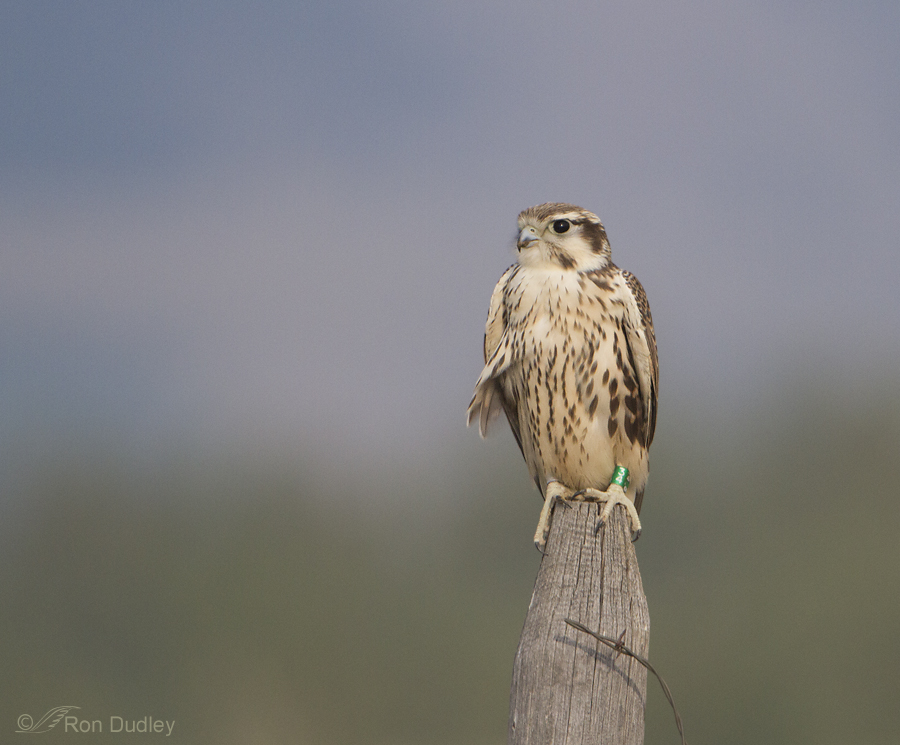

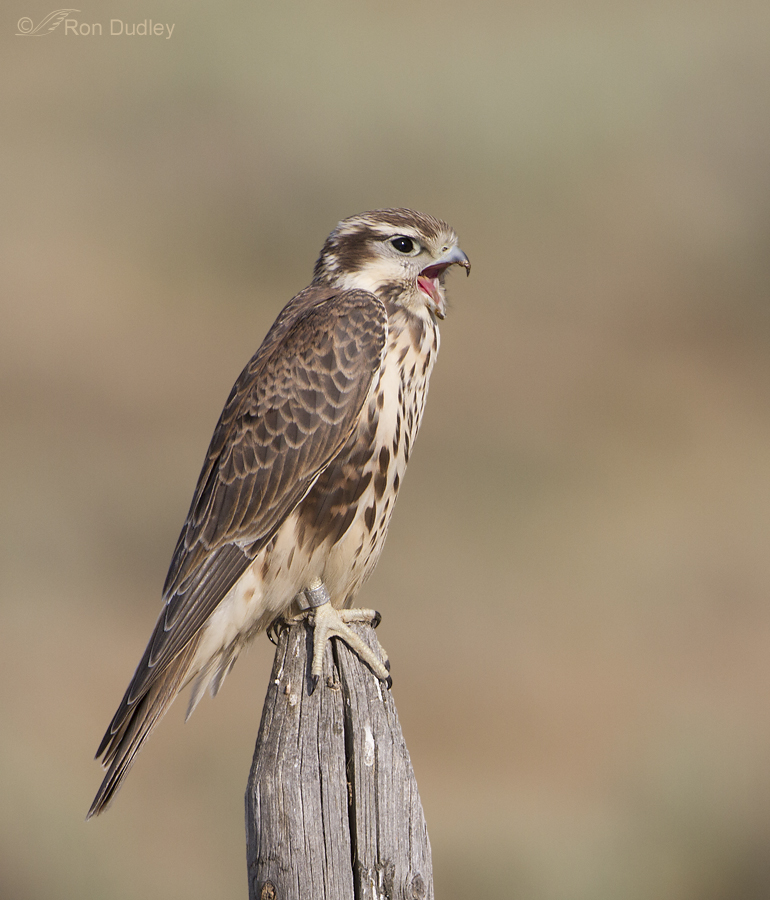
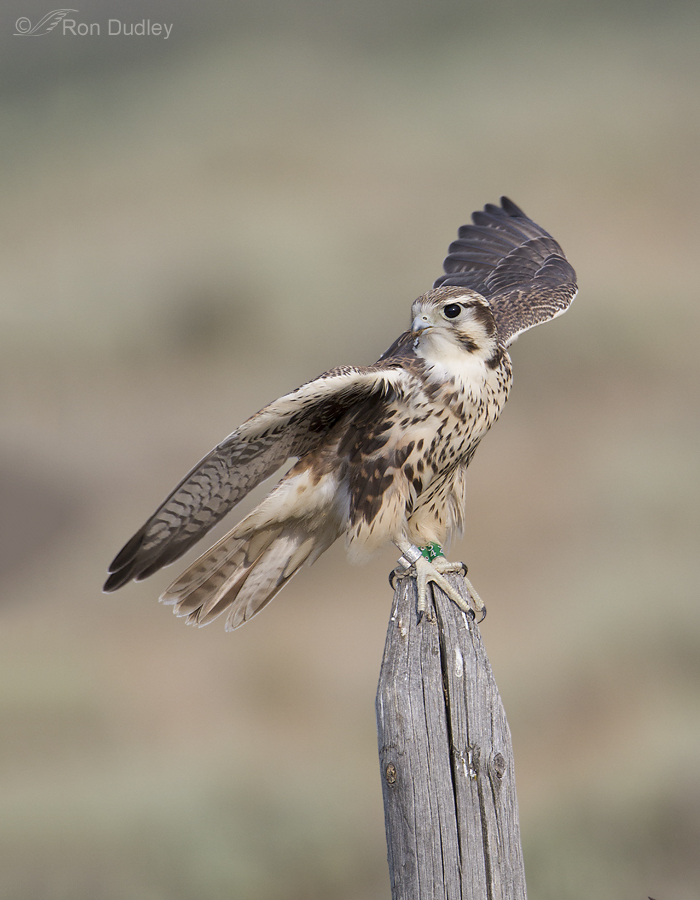
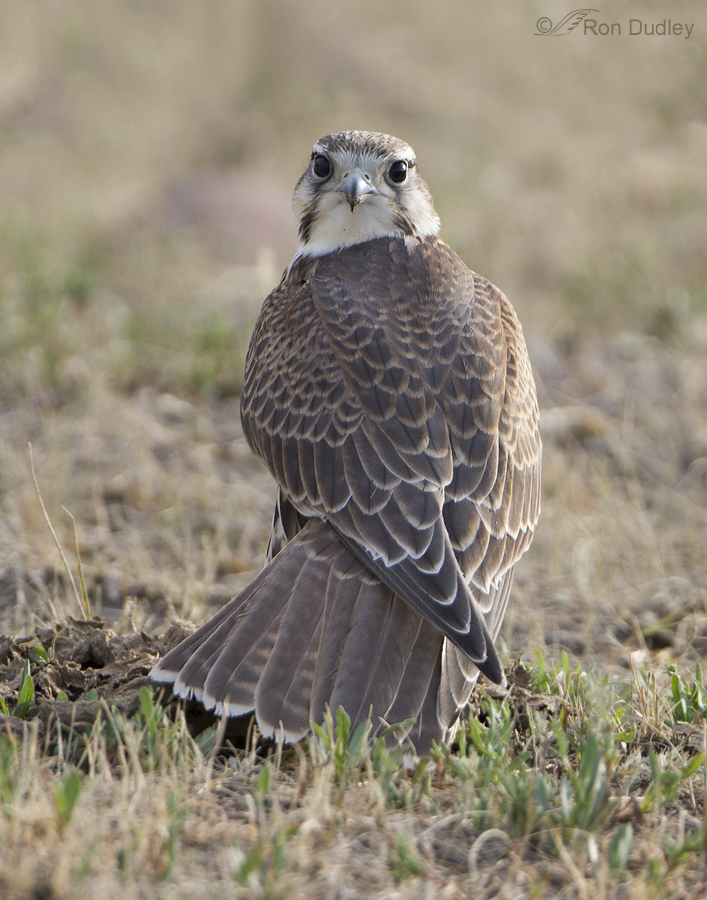
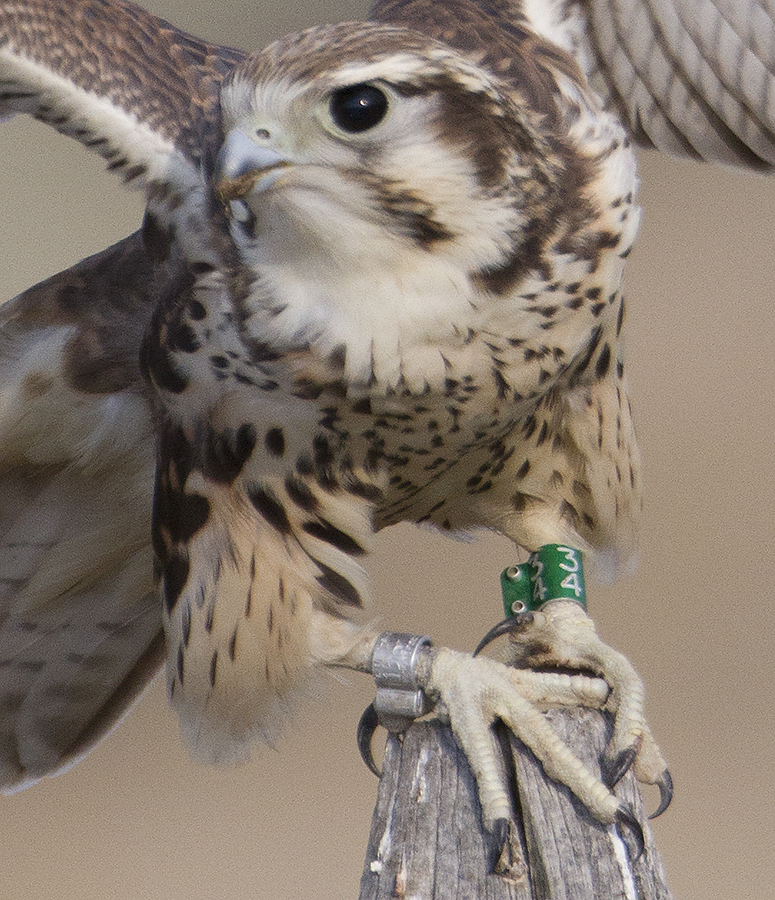
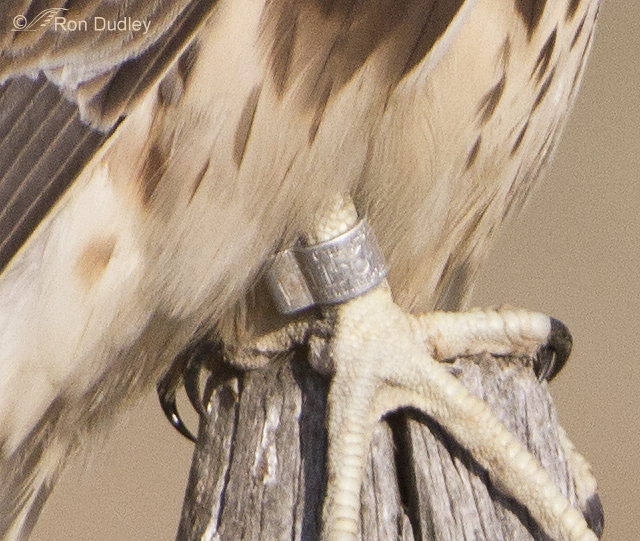
Hi Ron,
Please report all banded birds to this link at the Bird Banding Lab:
http://www.pwrc.usgs.gov/bbl/
It’s a bit of work, but you will learn the origin of the bird banding, how old he/she is, etc. It’s worth your time!
It also helps the researchers with recorded documention for even 50 years from now.
Thanks in advance,
DeeDee Gollwitzer
I was working my way backward through your posts, so I read the outcome before seeing these shots. How truly beautiful — the bird, and your captures of him. btw, I just now looked up the specs on the 500 f4. I’ve seen them in the field but hadn’t explored in detail. What a piece of glass that must be to shoot with! Can you hand hold or is it too heavy to stabilize in hand?
Can you hand hold or is it too heavy to stabilize in hand?
This is really cool! I’m glad you got the info on this bird. Juvenile dispersal is so fascinating. It is so exciting that you take some exceptional photos, and beyond that, some extremely interesting information comes about.
Bryce: We have seen juvenile Bald Eagles migrate north within a short time after fledging from the Channel Islands (known from banding info)to southern B.C. and (more likely) east into Nevada. Migration is not always south in fall and north in spring in raptors but far more about movement in whatever direction in search of food.
Bill
Ron,
These are superb photos. I am so glad you were able to contact Doug Bell, the Master Bander that banded this bird. I am also in the photo from him with the goofy hat. We have been banding prairies for many years and in fact, I have had two separate band recoveries from Montana from birds we banded in the nest in the San Francisco Bay Area. This data confirms the already widely accepted fact that California prairie falcons head to the Great basin post fledging to feed on the abundant prey, mostly ground squirrels. Thanks again for posting these photos. Capturing that much detail is a rare event. Cheers.
Thanks very much, Joe. I’ve been learning a lot this afternoon about the work you folks have been doing with Prairie Falcons. My post tomorrow morning (assuming there’s no more hiccups from Network Solutions) will highlight the wonderful work your team does and bring my readers up to date on the history of this bird (I’m working on that post now). And yes, everyone will get to see your “goofy hat” (I love it!)
Wow! I was unaware of the post-fledging dispersal pattern. That’s quite a distance! Joe, where can I find more information on your Prairie Falcon work? Is it part of the Altamont study? East Bay Regional Parks, or…? Thanks for this info.
Dick, here’s a link with some more info. http://www.ebparks.org/stewardship/wildlife/falcon_study
I’ll go into it quite a bit on tomorrow morning’s post, including photos.
This is clearly a bird with lots of personality. I love all of the photos, especially the ones which show the bird’s feet. Those feet are amazing. This is one gorgeous bird. I’m also glad to see that so many people know about banding.
I couldn’t agree more, Susan – those feet are VERY impressive!
Wow! Wow! Wow! What amazing fantastic shots Ron! I would love to know about the banding. Thanks so much for sharing!
Stay tuned, Charlotte. Much more info about the banding and the history of this bird coming up in tomorrow’s (Thursday’s) post.
Thank you, Susan, Cindy and Harmony. Due to the behind-the-scenes sleuthing of Mike (comment below) it’s possible that we may learn something soon about where, when and why this bird was banded and by whom. If it pans out (maybe it will, maybe it won’t) I’ll be sure to report back. Very exciting! Thanks Mike!
Wonderful images, as always — and I’m on the edge of my seat to know more.
Wonderful images!
Nice pix, beautiful falcon..can’t wait to hear the rest of the story. I love a mystery!
Even if the bander hasn’t submitted his data yet, the BBL could probably contact him/her for you – don’t know if they’ll give out contact info, but with the prefix on the silver band, they will know to whom they issued that band. The green band will tell the bander which bird you saw. Beautiful youngster! I’m wondering if he spent some time in captivity, given his nonchalance around you – though I don’t think anyone is breeding them for release and as has been explained, those are neither captive bred nor falconry bands – but perhaps he came into a rehab center as an orphan and was banded before release. I can ask some rehab contacts.
I wondered the same thing about the possibility of recent captivity for this bird, Louise. Many of the Prairie Falcons I saw on this trip were unusually approachable (for the species) but I think that’s because they were so focused on the grasshoppers they were hunting from fence posts along the road. But this one was the tamest of the bunch.
Mike thanks for confirming a suspicion I had. That there would be at least 5 numbers on the silver band. Here in B.C. we often have a letter before the numbers on the silver bands (not USFW bands) we use on our wild raptor banding. So I thought there would be one more digit on this falcons band. Sorry for the claim the bands are from Washington rather than Maryland we here just think of them as Federal Government. LOL
Bill
Thanks for getting back to Mike on this, Bill.
Ron, these are incredibly beautiful, detailed shots…each one is a winner…the series is amazing! Regardless of who banded this bird or why, I wonder how the bird feels about wearing them. I don’t even like wearing a watch or bracelet most of the time. I know, and accept, that it’s for a good cause, but sometimes I wonder….
I’m like you, Patty I also have mixed feelings about banded birds but part of my reservation about it is selfish – I prefer to photograph birds without “jewelry”. On the other hand I’m glad the research is being done – raptors in general need all the help they can get.
The silver band is issued by the Bird Banding lab in MD, the federal agency that oversees bird banding in the US in coordination with a parallel agency in Canada. The 4 visible numbers are called the prefix. It indicates the band allotment to the bander along with the size, in this case 6. Prairie Falcon males commonly take a 6, but it’s also used on small females. Bands are allotted in strands of 100, all sharing the same prefix. The prefix is followed by 5 more digits that are all in sequence: 00001, 00002, etc.
The large green band is called a “resight” band. They’re generally placed on nestlings by researchers. Brightly colored bands with big number/letter combinations make it easier to identify individuals in a population without having to continuously catch the bird. They’re common in dispersal and nest fidelity studies.
Someone will be interested in seeing your picture along with the where/when info, but the BBL probably won’t be able to provide the details on the bands yet. This is a juve and was only banded recently. A lot of researchers wait until the end of the season to submit their data. I’ll call around to try and find out who the bander might be. Great pics as usual!
I was hoping you’d weigh in on this, Mike. Thanks so much for your input! I’ll provide the link to RRL NWR today – perhaps the refuge manager knows who’s been doing Prairie Falcon research in the area. If you get any hits when you’re “calling around” about the bander, please report back.
Hi Ron,
Very interesting discussion, and I’m looking forward to learning more about the who/what/where/when regarding the banding of this immature Prairie Falcon. That said, these are beautiful images of a beautiful bird!
Thank you,
Dick
Prairie Falcons have charisma…
I couldn’t agree more, Dick – Prairie Falcons kinda grab me. I like the discussion too – I’m still trying to sort it all out…
Being Canadian I am not aware of all the US protocol on banding but my take on the placement of these bands is different than Marks. These band were likely placed (as has been suggested) at the eyre. Wild raptors are not given seemless bands (those are reserved for captive bred raptors [in NA]). Seemless bands must be placed on the tarsus/foot prior to about 3 weeks of age. This gets tricky at the eyre with a clutch and gender variables. Bands that are open until placement are far more bander and raptor friendly. They usually go on (if at the nest) after 3 weeks of age so they can not fall off but can be placed at any age after that time. The silver band is a regular band used for non-specific research while the colored band is used for more specific research by a specific research program. The value of the colored band is greater ease of providing info to an observer. Larger, fewer and greater contrast of the characters makes reading via scope or binos more possible/accurate. These coloured bands can contain letter or numerical characters or a combination. In some research there is a significance to which tarsus is used for the colored band (gender specific).
Here are a couple of links that may help better explain the banding process.
http://www.birdpop.org/DownloadDocuments/Alpha_codes_english.pdf
http://www.pwrc.usgs.gov/bbl/
On the use of Prairies for falconry, they lost favour some years ago because of their “difficult personality” compared to Peregrines or hybreds but are making a bit of a comeback. They are extremely hardy and amazingly brave.
Bill
Interesting info, Bill. I’ll definitely check out the links you provided this afternoon. Thank you.
Hi Ron,
I’ve had success reporting bands to the USGS bird banding lab. Their web site is http://www.pwrc.usgs.gov/bbl/. They may be able to connect you with bander and exchange info. Good luck!
Chris
Thanks for the link, Chris. I visited the site but couldn’t get the “report a bird band or a marked bird” link to work. I’ll try again later.
The dark green band is a federal band under the Migratory Bird Treaty Act. Several countries have thier own color. That type of aluminum closed band is usually for breeders and maybe research birds. I know that Prairie Falcons have a different kind of migratory pattern, moving east/west and have been studied for fear of possible population drops. The average life span in the wild is around 5 years, but maybe this guy is older. Its my understanding that studing the Wyoming and Utah population is quite productive, and see many references to the ones done in 2005.
Tim
Thanks, Tim. I’m thinking this is a hatch year bird.
I’ve haven’t been lucky enough to see a Prairie Falcon in person, and I thought maybe he was an adult. The reference pictures I have show first year birds with much more chest markings and darker in general. But after going on an internet “binge” I can see my mistake.
I loved a video I found of a guy banding PF’s in the nest in Canada. He was a character, and used the same style band we see in your pictures.
Tim
Tim: Another visual to differentiate between juvenile and adult Prairies is the color of the toes, feet and cere. The juvenile falcons have pale coloration while adults a bright yellow.
It might be nice to see the video of the banding if you can post a link.
Bill
Thanks for the info William!
Here’s that video:
http://www.youtube.com/watch?v=rc5zX9qr-kc
Tim
Tim: Thanks greatly for posting that video link. The gentleman doing the banding and a fellow he mentioned in the running commentary are both acquaintance of mine. Both falconers in Alberta and have been involved for decades in many aspects of Alberta’s raptor welfare. John (the bander) while being quite a character has devoted a great deal of his life to raptors.
Some folks may find it interesting how low some of the eyries were. This is quite common for the species, unlike the Peregrine.
Ron: The descriptive “irascible”, easily angered or prone to express irritation may have been borrowed from one of the books I recommended earlier on raptors and is some of the reason for many falconers choosing another falcon species to fly.
Bill
Hi Ron,
This juvenile is certainly the subject of someone’s research, likely banded this spring in the nest, based on the USGS and color band, and not a falconer’s bird. The images are simply amazing. Thanks for sharing.
Thank you, Gail.